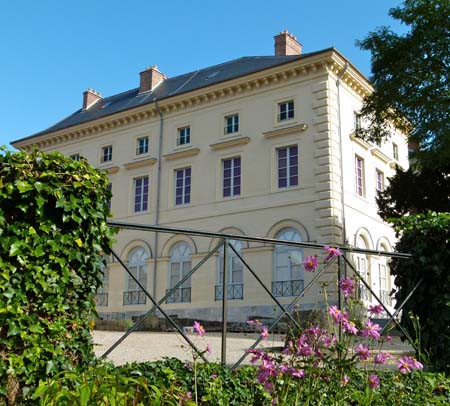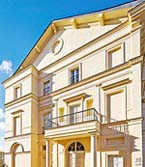In August 1806, the architect Auguste Famin, architect in chief of the chateau de Rambouillet, was charged with the reconstruction of the government building of Rambouillet, which Napoleon destined for his son, the King of Rome, born in 1811. Famin won the Prix de Rome in 1801, Famin had stayed at the Academie Française in Rome from 1801 to 1806. On his return to France, he had helped Fontaine with work projects at the Chateau de Rambouillet, before becoming head architect.

Commisioned by Louis XVI from the architect Jacques-Jean Thévenin (1732-1813), amongst a series of royal buildings (bailiwicks, prisons, the hôtel de la Venerie), the hôtel du Gouvernement was built between 1784 and 1787. It is comprised of a main building enclosed by two pavilions, which extend to the street via an low wing, which makes up the central courtayrd. The south facade opens onto a garden which adjoins the royal gardens. Made a national building after the Revolution, it was sold to Joseph-Yvon Paulian, deputy of Saint-Domingue who lived in Paris, who little by little sold off the stones of the main body of the building.
On 28 Floreal; year XII (18 May 1804) a senatus consulte integrated what was left of the hotel into the civil list of the Emperor. The hôtel du Gouvernement took the official name of the Palais du Roi du Rome on 2 March 1812.
Keeping to the original plan of the whole, Famin was inspired by the architecture of Tuscany, in his reconstruction of the main body of the palace and the two pavilions, of which only the low wings were kept. On the facades of the courtyard, the bay windows of the ground floor were vaulted with accentuated key bricks, those of the corner floors were squared, the levels between the floors marked by mouldings. The angles are covered by chains of shells in bas-relief. The hallway was decorated with four doric columns on the ground floor, and four ionic columns on the first floor. A doric porch on two columns surmounted the front steps of the courtyard, whereas a large balcony in the ionic style which embellished the first floor of the side overlooking the gardens. The courtyard was enclosed by a supporting wall, topped by railings interspersed by pilasters, opened by two doors. The main body housed the apartments of the King of Rome and the reception rooms, the pavilion and the low wing housed the porters’ lodgings and other rooms for the staff.
The King of Rome never stayed in this house, which was occupied since 1816 by the new governor of Rambouillet named by Louis XVIII, the duke of Sérent. Taken from the civil list by the King in 1832, the hôtel du Gouvernment was sold to a private owner in 1835, the main building was demolished (between 1836 and 1841). Only the wings remain today, of which the roofing and the facades were registered as historical monuments in 1966.
After many years of restoration work, the western wing, which has belonged to the town of Rambouillet since 1989 and which houses temporary exhibitions, reopened its doors in March 2013.
As well as strengthening the existing edifice, the work has also highlighted the italianate style of the building.
On the western facade, the windows of the top floor which had been enlarged at the expense of their frames, have been restored to their original dimensions and are now surrounded by their original mouldings. On the southern facade, the decoration in relief, which were damaged by weather exposure, have also been restored.
Irène Delage, March 2013 (tr. A.M)
INFORMATION
Type: Monuments, parks and gardens
Region: Paris and Ile de France
Themes: History, art and culture
Address: Place du Roi de Rome 78120 Rambouillet
Telephone: +33 (0)1 34 83 10 31
Temporary exhibitions are open to the public from Wednesday to Sunday from 2pm to 6pm, including holidays, except 25 December and 1 January.
The gardens are open 2pm-6pm


